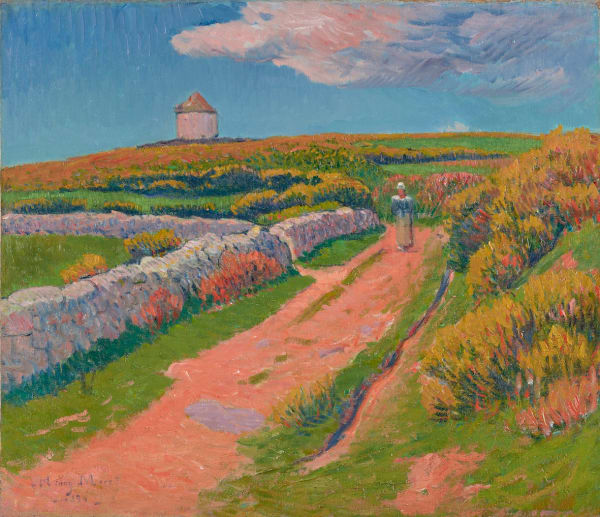Rhythm of lines and colours in French Avant-Garde
Stoppenbach & Delestre is pleased to present 'Rhythm of lines and colours in French Avant-Garde', an exhibition including works by Charles-François Daubigny, Eugène Boudin, Armand Guillaumin, Hippolyte Petitjean, Louis Valtat, Henry Moret, Emile Bernard, Kees Von Dongen, Henri Manguin, and André Derain.
The exhibition investigates the visual language of imagination in paintings through the interplay of lines and colours. Throughout the early stage of modern art, the aggregation of forms and colourful textured surfaces, central to translate the sensation of the artist, embodied their ongoing pursuit of change and transformation in their approach of painting practices.
In his 1911 article 'Post-impressionism' published in The Fortnightly Review, Roger Fry states that 'Rhythm, [is] the fundamental and vital quality of painting, as of all the arts – representation is secondary to that, and must never encroach on the more ultimate and fundamental demands of rhythm.'
The new research on the physiological role of colours ("Helmholtz's Treatise on Physiological Optic 1867") and their impact on human's perception have put in question the distinction between reality and imagination and opened new paths for artists.
The research in neurology and psychology, such as in the field of consciousness led to new ideas concerning perception, which served to redefine the balance of forms, lines, strokes and colours towards more subjectivity. It further set new boundaries to the pictorial possibilities.
Taking the evolution of rhythm and lines in painting as a point of departure, the exhibition retraces the development of perspective from academic art to the impressionist and post-impressionist painterly traditions. It explores the major shift from representational paintings to new forms of compositions, which reconsidered painting's nature, focusing on new pictorial languages revitalizing the rhythm of play between colours and structured designs.
The artists on view shared between them many of the same concerns for new forms of compositions that reflected a new modern outlook, symbolizing the blooming of new ideas that emerged in a great number of fields such as literature, art or philosophy.
If, in their compositions, painters Eugène Boudin and Charles-François Daubigny, focused their attention on depicting nature, paving the way for a new form of landscapes paintings, Guillaumin's use of a colourful and vibrant palette and dynamic brushwork address Impressionist interest for transcending their compositions.
Concerned with colour theory and new researches on the ability of the eye and mind of the spectator to blend colours dots into vast nuances, The Neo-Impressionist artist Petitjean harmonizes his Pont Neuf composition in a lighter palette, balancing warms and cold colours, bold and calm nuances, interplayed with a quick and precise brushwork.
Henry Moret and Emile Bernard highlighted the significance of forms, synthetizing lines while employing larger patches of colours to convey emotions to their works.
While in Valtat's work, the artist suggests intimacy through the use of curved lines and dynamic brushwork, Van Dongen, Derain and Manguin, highlights the importance of bold colours to revive the intensity of compositions and record the artist’s emotions.
The works showcased in this exhibition embody how this modernist period fosters new notions of rhythms, asserting painting's development, while pushing the diktat of the academy, and establishing new practices that influenced later modern and contemporary art forms.
-
 Armand GuillauminGuinguette au bord de la Seine, 1873Oil on Canvas54.1 x 65.2 cm
Armand GuillauminGuinguette au bord de la Seine, 1873Oil on Canvas54.1 x 65.2 cm
21 ¼ x 25 5/8 inchesSigned and dated lower right -
 Henry MoretLe chemin rose, 1894Oil on canvas45.7 x 53.3cm
Henry MoretLe chemin rose, 1894Oil on canvas45.7 x 53.3cm
18 x 21 inchesSigned and dated lower left Henry Moret 1894Sold -
 André DerainLes trois Grâces, c. 1906Watercolour on paper47.7 x 60.5 cm
André DerainLes trois Grâces, c. 1906Watercolour on paper47.7 x 60.5 cm
18 13/16 x 23 13/16 inchesSigned lower right a.derain Watermark Bristol lower left -
 Raoul DufyMoisson en Normandie, c.1928Gouache & Watercolour on paper68 x 100 cm
Raoul DufyMoisson en Normandie, c.1928Gouache & Watercolour on paper68 x 100 cm
26 ¾ x 39 3/8 inches
Signed on the lower center "Raoul Dufy”Sold












